Sustainable Stewardship: Hog Farm Commits to Eco-Friendly Efforts
Some consider farmers to be the first environmentalists. Today that idea continues to resonate with award-winning modern pork operations, such as Pembroke Oaks Farm in Wheatfield.
This green business was named one of just four environmental stewards in the country by the National Pork Board and National Hog Farmer magazine.
Located in northwestern Indiana, Pembroke Oaks Farm is dedicated to providing an environmentally comfortable atmosphere for animals and employees alike, as well as incorporating state-of-the-art technology in its pig facilities.
Launched in 1995 as a 1,200-sow farrow-to-finish operation, Pembroke Oaks retooled and upgraded in 2006 to accommodate the growing industry for breeding pigs. Belstra Milling Co., a feed purveyor, also provides management and support services for Pembroke Oaks and the five other farms within the company’s structure.
“The Wheatfield site now houses 2,400 sows producing 75,000 hogs annually,” says Jon Hoek, Pembroke’s production strategies officer. The weaned animals then move to the company’s St. Ann, Ill., site to finish growing before they’re sold.
Fine Swine
Pembroke Oaks’ 15 full-time employees, as well as 85 others working at the rest of the farm sites, ensure commitment to animal care, environmental controls, and a safe and high quality protein product is the highest priority.
“We are called to be environmental stewards for all our operations,” says Kurt Nagel, financial analysis and environmental compliance officer for Pembroke Oaks. “Everything we do is intentional.”
Pembroke Oaks makes certain the pigs are kept comfortable, too. “The barns operate with cool cells through the walls, thereby cooling pigs in the summer,” Nagel says. “We use heaters in the winter.”
The cooled walls also enable the operators to monitor water quality. Snout coolers, part of the air-controlling system, provide cool air comfort for hogs.
Even with high-end technology, the company constantly monitors efficiencies. “Our carbon footprint tells the tale,” Hoek says. “Where we used to feed 4 to 5 pounds of corn to make 1 pound of pork, we now feed 2.5 to 2.8 pounds of corn. The improved efficiency shows it takes 5,000 acres less corn to feed our pigs today than 30 years ago. Now, the 5,000 acres of corn can be used for other purposes.”
Hoek emphasizes their pigs’ genetic improvement occurs through natural selection and data collection, not through genetically modified organisms (GMOs).
Going Green
The farm cautiously watches all aspects of production – even the manure output, which gets recycled into nutrient-rich fertilizer. The manure in the pits under the hog barns becomes in the spring and fall to fertilize the soil in nearby fields, which contributes to the following year’s corn crop.
“We make sure things run correctly from a management standpoint and through the manure application process,” Nagel says. “We’re aware of our neighbors and make sure there is little odor when the manure is injected in area fields. Nutrient content boosts next year’s crops.”
One of Pembroke Oaks’ largest neighbors is the 8,000-acre Jasper-Pulaski State Fish and Wildlife Area. When the hog operation was in the planning stages, they sought out the Indiana Department of Natural Resources to assure the agency they would be worthy stewards of the adjacent land. They also pledged that the annual migration of 40,000 sandhill cranes through the area would continue to be protected.
Feeding the World
Belstra Milling’s annual pig production totals around 300,000. The majority of hogs are sold for meat, although about 30 percent are sold as breeding stock. “A small percentage is used in the human medical field for surgical reconstruction material for burn victims,” Hoek says.
Though that production number may seem sizable, Nagel reminds us that few countries outside the United States can feed themselves. “Farming has adapted to the needs of the world,” he says, “but it’s mostly the same farm families, generation after generation, that are growing your food.”
He underlines the significance of the change from agrarian to urban lifestyles. “The romanticizing of the ’40s and ’50s is not really romantic at all,” Nagel says. “Droughts, dust bowls and more crop failures than any other time showed us that that level of ag does not feed the world as the United States has to do. Farms have gotten larger because the population has grown.”
“Most farmers are in it for more than just the money,” Hoek says. “It’s a business, but it’s also a calling. We want people to know we are committed to making moral and ethical decisions in everything we do. It’s a blessing to feed the world.”









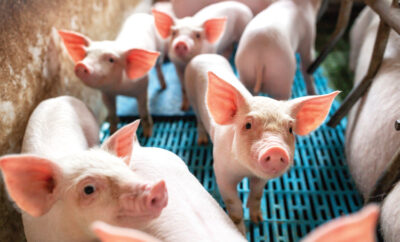
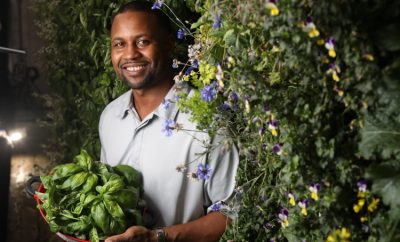

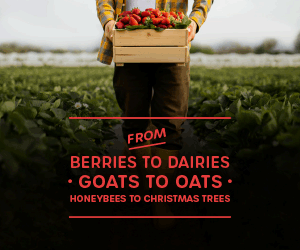

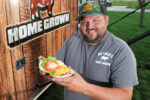
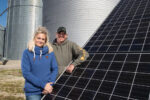


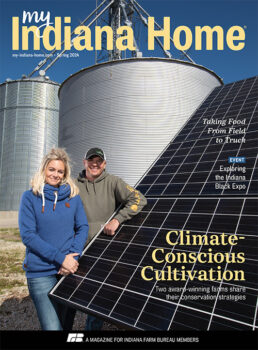 My Indiana Home is produced for Indiana Farm Bureau members. Our mission is to connect you with the food you eat, the Indiana farmers who grow it and a rural lifestyle that is uniquely Hoosier.
My Indiana Home is produced for Indiana Farm Bureau members. Our mission is to connect you with the food you eat, the Indiana farmers who grow it and a rural lifestyle that is uniquely Hoosier.
Marcin
November 18, 2014 at 6:42 am
Going green? How about caring for the animal’s welfare. The gestations crates these poor pigs are crammed into the entire life are banned in other countries. This article completely ignores the issue and promotes animal abuse by concentrating on going “green”.
http://m.humanesociety.org/issues/confinement_farm/facts/gestation_crates.html
Jessy Yancey
November 18, 2014 at 4:05 pm
Thanks for your comment. Gestation crates, individual housing for sows during the time of pregnancy, are used so that individual sows can be fed relative to their individual needs and to reduce the impact of aggressive behaviors seen in group housing (i.e., many pregnant sows together in an open pen). They have been found to reduce aggressive behaviors and allow for more precise individual feeding management of sows. Hope this helps to explain why they are used on some farms, and we appreciate your feedback.